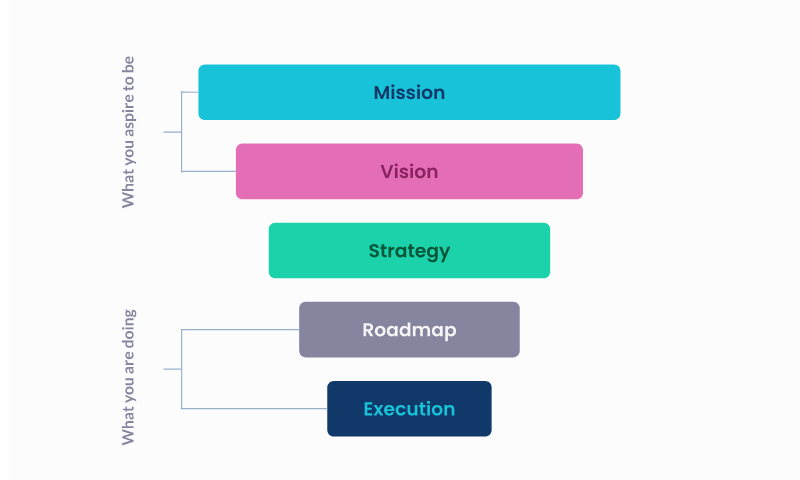Product strategy isn't just a buzzword—it's the backbone of every successful product company. The difference between products that change the world and those that fade into obscurity often comes down to one thing: a well-crafted, comprehensive product strategy.
The Product Strategy Hierarchy: From Vision to Execution
Great product companies have a clear hierarchy that flows seamlessly from high-level aspirations to day-to-day execution. This hierarchy ensures alignment across all levels of the organization and provides a roadmap for sustainable growth.
Mission: Your North Star
Your mission statement describes the fundamental problem you're solving and for whom. It's intentionally broad and stable, serving as your company's north star for years to come.
Example: Google's mission is "to organize the world's information and make it universally accessible and useful."
The mission sets the foundation, but it's deliberately vague. As you move down the hierarchy, concepts become more concrete and actionable.
Vision: Your Aspirational Future
While mission defines the problem, vision describes your idealized solution. A compelling product vision should be:
Relatable but not overly detailed
Inspiring enough to rally your team
Future-proof to serve as long-term guidance
Template for Product Vision:
For [target customers]
Who [have a certain need],
Our product is a [product category]
That provides [compelling reason to buy].
Unlike [product alternatives],
Our product [has these key differentiators].
Example: Yammer's vision was "Empower and connect every person across an organization to maximize their impact."
Strategy: Your Pragmatic Path Forward
Strategy bridges the gap between aspiration and action. It's a set of principles and decisions—informed by reality and bounded by assumptions—that maximize your likelihood of success.
Unlike vision (which should last years), strategy typically looks at a horizon of months to a few years and may evolve as new data emerges.
Roadmap: Your Strategic Manifestation
The roadmap translates strategy into concrete steps, complete with rough milestones and timelines. It describes what products and features will be built, who's responsible, and when they'll be delivered.
Execution: Your Daily Reality
This is where the rubber meets the road—the day-to-day activities that bring your roadmap to life through building, launching, and iterating.
The Product Strategy Formula
The most effective product strategies follow a proven formula:
Product Vision + Insights + Challenges + Approaches + Accountability = Product Strategy
Let's break down each component:
1. The Essence: Product Vision
Your product strategy should:
Connect to the company vision
Feel aspirational and long-term
Be fairly stable (pivot less than strategy)
Define what problems you're solving, for whom, and why now
2. The Logic: Product Insights
Strategic insights provide the foundation for smart decisions:
Data: What the numbers tell you about user behavior and market trends
Differentiators: How you stack up relative to competitors
Market Need: Understanding your audience, target market, and opportunity size
Market Trends: External forces influencing your business
Target Customer: Deep understanding of user personas and variations
3. The Roadblocks: Challenges
Identifying challenges upfront helps you prepare and plan:
Technology hurdles you anticipate
Customer pain points including emotional and psychological challenges
Go-to-market challenges and competitive risks
Legal/regulatory requirements you must navigate
4. The Solution: Approaches
Your approach should address identified challenges head-on:
Decide between single-focus or multi-pronged strategies
Outline high-level plans for overcoming challenges
Define what you will and won't do along the way
5. The Measure: Accountability
Clear metrics ensure you stay on track:
North Star metrics for strategic and visionary goals
Perceptual measurements like engagement and satisfaction
Value measurements such as sales, leads, and ROI
Real-World Application: The Zoom Case Study
Let's see how this formula applies to a real product. Zoom's success didn't happen by accident—it followed a clear strategic framework:
Vision
"For remote teams, educators, and individuals who need efficient, reliable, and easy-to-use virtual communication tools, our product is a versatile video conferencing platform that provides high-quality video and audio, screen sharing, and collaboration features."
Key Insights
Target Audience: Remote teams, educators, individuals needing virtual communication
Market Opportunity: Video conferencing market growing at 9.2% CAGR, expected to reach $16.4B by 2023
Competitive Landscape: Microsoft Teams, Google Meet, BlueJeans, WebEx
Differentiators: Cross-device accessibility, security, scalability
Major Challenges
Technical: Building a secure, scalable platform handling massive concurrent users
Customer: Creating intuitive UX with low learning curve
GTM: Fierce competition requiring strong differentiation
Legal: Compliance with HIPAA, GDPR, and other regulations
Strategic Approaches
Focus on reliability, security, and seamless user experience
Invest heavily in infrastructure and technology for scalability
Provide extensive support and training materials
Ensure compliance from day one, not as an afterthought
Accountability Metrics
User adoption rates
Customer satisfaction scores
Revenue growth (targeting 30% growth rate)
Monthly active users (goal: 50 million MAU)
From Tactical to Strategic Thinking
As you progress from Product Manager to Product Leader, your role fundamentally shifts. You move from excelling at tactical execution—requirements gathering, research, sprint management—to thinking strategically about long-term vision and securing executive buy-in.
Strategic thinking means:
Thinking long-term: How do individual features ladder up to overarching goals?
Seeing connections: How do smaller components complement each other?
Understanding context: How does everything fit together to impact user needs?
Key Takeaways for Product Leaders
A well-crafted product strategy should:
Align everyone around what's most important so the entire team rows in the same direction
Help you say no to distractions and prioritize truly impactful items that move you toward your vision
Inform organization of your product teams and resource allocation
Remember: strategy within this framework bridges the gap between what you aspire to be and what you're actually doing. Without this bridge, even the most inspiring vision remains just a dream.
The companies that win aren't necessarily those with the best ideas—they're the ones with the clearest path from vision to execution. That path is your product strategy.
Ready to craft your own game-changing product strategy? Start with your vision, ground it in insights, acknowledge your challenges, define your approaches, and establish clear accountability measures. The formula works—but only if you work the formula.



